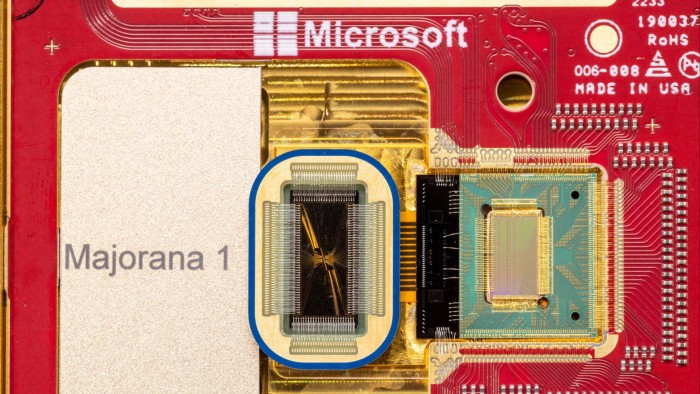Unlock the Editor’s Digest at no cost
Roula Khalaf, Editor of the FT, selects her favorite tales on this weekly publication.
In 1947, the primary transistor, the fundamental constructing block for a digital laptop, was made utilizing a semiconducting materials regarded as perfect for the duty: germanium. The concept of utilizing silicon didn’t come up till halfway by way of the following decade, and it wasn’t till 1960 {that a} skinny layer of oxidised silicon, present in right now’s most generally used transistors, was added.
Quantum computing, the large hope for fixing issues out of attain of right now’s computer systems, continues to be struggling to succeed in its personal silicon second. A number of the largest tech firms have began ramping up their makes an attempt to construct a working machine, satisfied that the sector has lastly handed the brink between fascinating science experiment and sensible engineering problem.
But there is no such thing as a consensus about one of the simplest ways to take advantage of fundamental components of quantum computer systems, generally known as qubits — or certainly, whether or not future machines might be primarily based on an array of various applied sciences slightly than only one, with several types of machine suited to completely different computing issues.
This lack of settlement on one thing so fundamental is a sobering reminder of how far quantum computing nonetheless has to go to show itself. It additionally means that the race taking form between a few of the largest tech firms is more likely to produce winners and losers, as some qubits fail to pan out.
This week it has been the flip of Amazon, a relative newcomer to the realm of quantum {hardware}, so as to add to the multiplying array of applied sciences. Its entry, generally known as cat qubits, is known as after Schrödinger’s Cat, one of the crucial misunderstood thought experiments in science (the Austrian physicist used his feline paradox to make the purpose that it was nonsensical to assume {that a} cat locked out of sight in a field might be each alive and lifeless on the similar time, opposite to what many consider).
Cat qubits hint their origins to analysis at Yale College a decade in the past and had been first pioneered by French start-up Alice & Bob, whose €100mn fundraising final month is an indication of rising confidence that the expertise is able to transfer past the lab. The elements are designed in a means that suppresses one of many widespread sorts of error that have an effect on all qubits, making them much less liable to the “noise” that builds up inside machines because the programs achieve in scale.
All quantum computer systems work by encoding info on a number of qubits to make up for the instability of every particular person element. The much less error-prone the qubits, the less the quantity wanted. Amazon’s first rudimentary quantum chip, constructed from 9 qubits, achieves the efficiency of different sorts of quantum chip utilizing 50-100, in accordance with Oskar Painter, the corporate’s head of quantum {hardware}.
The corporate’s progress, marked by a paper in Nature, follows Microsoft’s declare that it lastly has one thing to point out from its 20-year pursuit of an much more radical kind of qubit, primarily based on exploiting a brand new state of matter.
The 2 firms’ prototype chips — Microsoft’s Majorana 1 and Amazon’s Ocelot — are nonetheless years behind the leaders within the discipline, like Google’s Willow and IBM’s Heron. These and others are primarily based on several types of qubit with an extended monitor report. Even when Microsoft and Amazon are proper in claiming they’ve superior elements, they’ve an extended approach to go to point out they can be utilized to construct sensible machines that leapfrog the competitors.
There are apparent parallels with the present race between the largest tech firms to develop their very own AI chips. Painter says Amazon’s goal in quantum is similar as it’s in AI: whereas its cloud arm, AWS, plans to supply clients each kind of chip available on the market, its personal in-house chip will act because the anchor. That makes the chip efforts, each in AI and quantum, of strategic significance to the largest tech firms.
In quantum, a lot will depend upon whether or not the race seems to be a dash or a marathon. Latest advances, just like the progress in error correction Google reported final yr, have introduced optimistic estimates of a sensible quantum laptop by the tip of the last decade. But Nvidia CEO Jensen Huang shook the quantum world earlier this yr along with his estimate of 15-30 years, whereas Painter at Amazon predicts that working machines are nonetheless 10-20 years away.
If cautious estimates are appropriate, it’s questionable what number of of right now’s quantum analysis efforts will survive. For even the best-funded start-ups, a wait of a decade could be punishing. And because the completely different quantum architectures are scaled up, some consolidation round fewer fundamental applied sciences appears probably.
richard.waters@ft.com

Leave a Reply